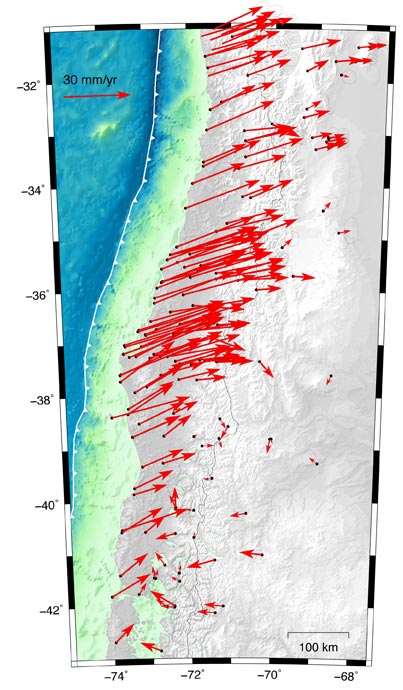Great earthquakes, water under pressure, high risk

GPS measurements of the displacement vectors (Image: GFZ)
The largest earthquakes occur where oceanic plates move beneath continents. Obviously, water trapped in the boundary between both plates has a dominant influence on the earthquake rupture process.
Analyzing the great Chile earthquake of February, 27th, 2010, a group of scientists from the GFZ German Research Centre for Geosciences and from Liverpool University found that the water pressure in the pores of the rocks making up the plate boundary zone takes the key role (Nature Geoscience, 28.03.2014).
The stress build-up before an earthquake and the magnitude of subsequent seismic energy release are substantially controlled by the mechanical coupling between both plates.
Studies of recent great earthquakes have revealed that the lateral extent of the rupture and magnitude of these events are fundamentally controlled by the stress build-up along the subduction plate interface.
Stress build-up and its lateral distribution in turn are dependent on the distribution and pressure of fluids along the plate interface.
“We combined observations of several geoscience disciplines – geodesy, seismology, petrology. In addition, we have a unique opportunity in Chile that our natural observatory there provides us with long time series of data,” says Onno Oncken, director of the GFZ-Department “Geodynamics and Geomaterials”.
Earth observation (Geodesy) using GPS technology and radar interferometry today allows a detailed mapping of mechanical coupling at the plate boundary from the Earth’s surface. A complementary image of the rock properties at depth is provided by seismology. Earthquake data yield a high resolution three-dimensional image of seismic wave speeds and their variations in the plate interface region.
Data on fluid pressure and rock properties, on the other hand, are available from laboratory measurements. All these data had been acquired shortly before the great Chile earthquake of February 2010 struck with a magnitude of 8.8.
“For the first time, our results allow us to map the spatial distribution of the fluid pressure with unprecedented resolution showing how they control mechanical locking and subsequent seismic energy release”, explains Professor Oncken. “Zones of changed seismic wave speeds reflect zones of reduced mechanical coupling between plates”.
This state supports creep along the plate interface. In turn, high mechanical locking is promoted in lower pore fluid pressure domains. It is these locked domains that subsequently ruptured during the Chile earthquake releasing most seismic energy causing destruction at the Earth’s surface and tsunami waves.
The authors suggest the spatial pore fluid pressure variations to be related to oceanic water accumulated in an altered oceanic fracture zone within the Pacific oceanic plate. Upon subduction of the latter beneath South America the fluid volumes are released and trapped along the overlying plate interface, leading to increasing pore fluid pressures.
This study provides a powerful tool to monitor the physical state of a plate interface and to forecast its seismic potential.
Marcos Moreno et al.: “Subduction locking and fluid pressure distribution correlate before the 2010 Chile earthquake”, Nature Geoscience, Vol. 7(2014), Issue 4, pp. 292-296, DOI: 10.1038/NGEO2102, 28.03.2014
Franz Ossing Helmholtz Centre Potsdam GFZ German Research Centre for Geosciences Deutsches GeoForschungsZentrum – Head, Public Relations – Telegrafenberg 14473 Potsdam / Germany e-mail: ossing@gfz-potsdam.de Tel. +49 (0)331-288 1040 Fax +49 (0)331-288 1044http://www.gfz-potsdam.de/
Media Contact
All latest news from the category: Interdisciplinary Research
News and developments from the field of interdisciplinary research.
Among other topics, you can find stimulating reports and articles related to microsystems, emotions research, futures research and stratospheric research.
Newest articles

High-energy-density aqueous battery based on halogen multi-electron transfer
Traditional non-aqueous lithium-ion batteries have a high energy density, but their safety is compromised due to the flammable organic electrolytes they utilize. Aqueous batteries use water as the solvent for…

First-ever combined heart pump and pig kidney transplant
…gives new hope to patient with terminal illness. Surgeons at NYU Langone Health performed the first-ever combined mechanical heart pump and gene-edited pig kidney transplant surgery in a 54-year-old woman…

Biophysics: Testing how well biomarkers work
LMU researchers have developed a method to determine how reliably target proteins can be labeled using super-resolution fluorescence microscopy. Modern microscopy techniques make it possible to examine the inner workings…





















